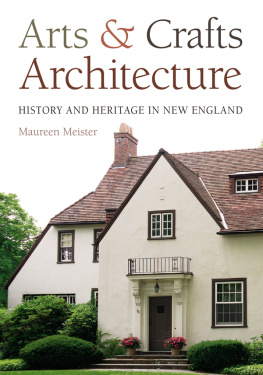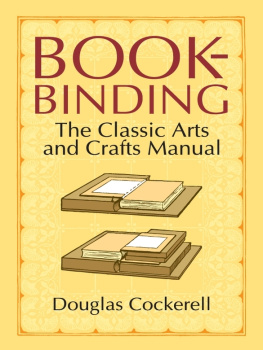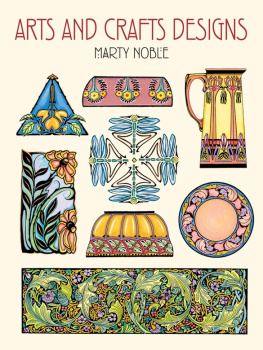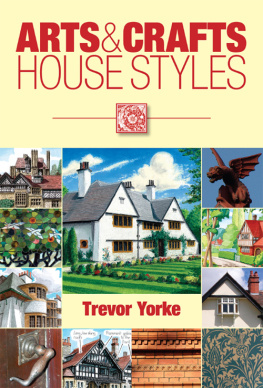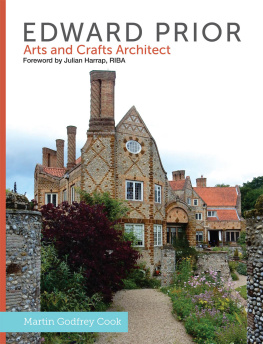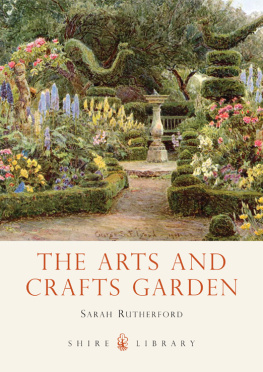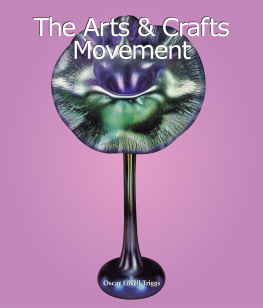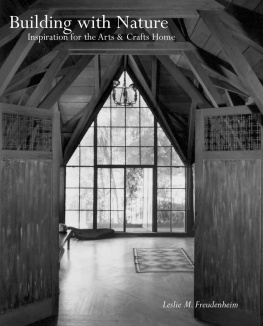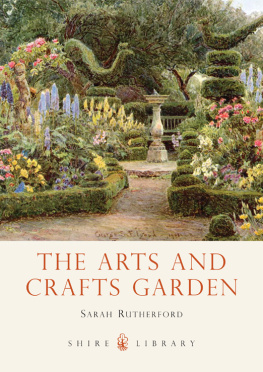Arts & Crafts Architecture
History and Heritage in New England
Maureen Meister
UNIVERSITY PRESS OF NEW ENGLAND
HANOVER AND LONDON
University Press of New England
www.upne.com
2014 University Press of New England
All rights reserved
For permission to reproduce any of the material in this book, contact Permissions,
University Press of New England, One Court Street, Suite 250, Lebanon NH 03766; or visit www.upne.com

This book has been published with the generous support of Furthermore: a program of the J. M. Kaplan Fund.
Library of Congress Cataloging-in-Publication Data
Meister, Maureen.
Arts and crafts architecture : history and heritage in New England / Maureen Meister.
pages cm
Includes bibliographical references and index.
ISBN 978-1-61168-662-3 (cloth : alk. paper) ISBN 978-1-61168-664-7 (ebook)
1. ArchitectureNew EnglandHistory19th century. 2. ArchitectureNew EnglandHistory20th century. 3. Arts and crafts movementNew England. I. Title.
NA715. M45 2014
720.97409034dc23
2014013798
Contents
Illustrations
Preface
On a late-summer morning in 2012, I drove to Lawrence, Massachusetts. For many months, while finishing the manuscript of this book, I had wanted to spend a day in this gritty industrial city. Lawrence was not unfamiliar to me. But what piqued my interest and drew me north were some special programs and exhibitions taking place at this time. Finally, there I was, first at the visitor center and then standing before the enormous doors of the Everett Mill, an intimidating brick pile that extends the length of several city blocks. Here was where the citys textile workers had reached a breaking point in January of 1912, walking off their jobs in what became known as the Bread and Roses Strike. Not settled until March, the walkout focused the nations attention on the brutal conditions endured by its mill workers.
I have long been awed by New Englands factories and their histories. In the early 1980s, I spent a summer employed as a guide at Slater Mill in Pawtucket, Rhode Island, and another summer at the National Park Service in the mills of Lowell, Massachusetts. While I was writing this book about turn-of-the-twentieth-century architecture in New England, images of the regions mill buildings sometimes flitted through my mind. Harsh sites, places of misery, they represent one of the many topics I have not pursued in providing a context for this study. The historian confronts seemingly endless numbers of intriguing avenues to explore and passes by them, mindful of the need to stay on course.
The subject that I have chosen to investigate has been ambitious enough. What has guided me has been a desire to examine the buildings and ideas of a group of architects, eleven men and one woman, who practiced in Boston a century ago while dedicating themselves to promoting a shared interpretation of the English Arts and Crafts movement. They participated in a rich discourse, centered in the region, about art and labor, and it permeated their work. My topic is the outgrowth of a book that I published in 2003, Architecture and the Arts and Crafts Movement in Boston: Harvards H. Langford Warren. Warren, an architect, had trained under Henry Hobson Richardson, established the architecture program at Harvard, and in 1897 helped found the Society of Arts and Crafts, Boston, leading it through the better part of its first two decades. In examining Warrens career, I considered how his ideas about design and history contributed to the regions largest and most influential Arts and Crafts organization. At the same time, I recognized that Warren was not alone in this endeavor. I wanted to learn more about the architects and their fellow advocates who advanced Arts and Crafts theories in New England.
In the course of my research, I have been surprised to discover how often these architects and their projects have touched me personally. One example is William E. Putnam Jr. He and his partner, Allen H. Cox, were the architects of the dormitory where I lived when I arrived in Massachusetts at age eighteen to study at Mount Holyoke College. My first classes were held in a lecture hall that Putnam and Cox also designed. Several other architects in this group left their mark at Mount Holyoke. R. Clipston Sturgis was responsible for a portion of the colleges campus plan, and the firms of Newhall and Blevins and Ralph Adams Cram were employed for various projects. Many years later, when I settled in Winchester, a suburb of Boston, I became interested in the architect Frank Patterson Smith, who moved to the community in 1895 and soon became Warrens business partner. Together they designed Epiphany Church, just up the street from me. As a result of this investigation, I see the influence of the architects in this circle virtually every day, whether Im in Boston or Cambridge, in neighboring suburban towns, or traveling to another part of the region.
In writing this book, I have sought to provide a broad understanding of these individuals and the buildings that are their legacytown halls and libraries, churches and houses, and schools and campus buildings. Stylistically, they reflect Englands and New Englands architectural traditions, designs that are Gothic Revival and Colonial Revival. Less obvious are the ways in which the designs are based in theory as well as history, ideas that originated in Englands Arts and Crafts movement and then were blended with the rich cultural and architectural heritage of New England. Studying and visiting these buildings over the past few years has been a pleasure because they are beautiful. But this experience has also been upliftingvery different from visiting the regions sprawling mills. These Arts and Crafts buildings were erected in a spirit of idealism, and when they survive, that spirit is still embedded in them.
...
Dozens of people have made contributions to this book, and I wish to extend my thanks to them. First I want to acknowledge the wonderful staff of the Winchester Public Library, the arts desk of the Boston Public Library, and the Boston Athenaeum. Time and again, they have located references and sources for me that have been more than a little challenging to track down. I also received help, always with a warm reception, from the Library and Archives of Historic New England. Many more dedicated librarians, archivists, and members of preservation offices answered my queries. Their knowledge and commitment have been remarkable, and I want to let them know how much I have valued their assistance. I am further indebted to the many people who answered my calls and opened buildings to mehomeowners, ministers and priests, and more than one church music director.
My knowledge about the regions built environment has been enriched by my students at Tufts University as together we have examined the buildings, landscapes, and public places of Greater Boston. My long association with the Department of Art and Art History at Tufts has been most rewarding, and I am grateful for the support I have received from the faculty as well as from Rosalie Bruno, Christine Cavalier, and Amy West.
Several academic societies and organizations have provided me with opportunities to share my research, and I want to express my appreciation to the people who have given generously of their time to make these experiences possible. At the 2007 conference of the Society of Architectural Historians, I was pleased to present a paper in a session that was organized by Jeffrey Karl Ochsner. In 2010 I participated in the Useful and Beautiful conference at the University of Delaware. Co-chairing a session with Kathryn Brush at the 2011 conference of the College Art Association was especially satisfying. I also wish to thank Florence Boos and the William Morris Society in the United States, whose 2013 meeting gave me another opportunity to present my work; and Lisa Koenigsberg and the Initiatives in Art and Culture, which included me in the 2013 conference held in Boston.

